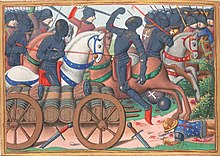Battle of the Herrings
| Battle of the Herrings | |||||||
|---|---|---|---|---|---|---|---|
| Part of the Hundred Years' War (And the Siege of Orléans) | |||||||
 Journée des Harengs (From Les Vigiles de Charles VII by Martial d'Auvergne, written c.1477-84, held by Bibliothèque Nationale, Paris.) |
|||||||
|
|||||||
| Belligerents | |||||||
|
|
|
||||||
| Commanders and leaders | |||||||
|
|
Sir John Fastolf | ||||||
| Strength | |||||||
| French/Scots ~4,000 men | English ~1, 500 | ||||||
| Casualties and losses | |||||||
| French/Scots 500 - 600 | English unknown, presumably light | ||||||
The Battle of the Herrings was a military action near the town of Rouvray in France, just north of Orléans, which took place on 12 February 1429 during the siege of Orléans. The immediate cause of the battle was an attempt by French forces, led by Charles of Bourbon, Count of Clermont, to intercept and divert a supply convoy headed for English forces. The English had been laying siege to the town of Orléans since the previous October. The French were assisted by a Scottish force led by the Constable of the Scottish army, Sir John Stewart of Darnley. There are two places called Rouvray in the region in question. In his biography of Sir John Fastolf, Stephen Cooper gives reasons why the battle probably took place near Rouvray-Sainte-Croix, rather than Rouvray-Saint-Denis.
This supply convoy was led by Sir John Fastolf and had been outfitted in Paris, whence it had departed some time earlier. According to Regine Pernoud, this convoy consisted of "some 300 carts and wagons, carrying crossbow shafts, cannons and cannonballs but also barrels of herring." The latter were being sent since the meatless Lenten days were approaching. It was the presence of this stock of fish which would give the somewhat unusual name to the battle. The battle was decisively won by the English.
The field of battle was an almost featureless, flat plain. The French army, numbering between 3,000 and 4,000, confronted the much smaller English force who had set up defensive positions by drawing up the supply wagons into a makeshift fortification. The entire defensive formation was then further protected by the placement of sharpened spikes all around to prevent the French cavalry from charging, a tactic which had been employed, with great success, at the Battle of Agincourt. The French attack began with a bombardment using gunpowder artillery, a relatively new weapon for the time and one whose proper usage was not well understood although it was damaging the wagons and causing English casualties.
...
Wikipedia
